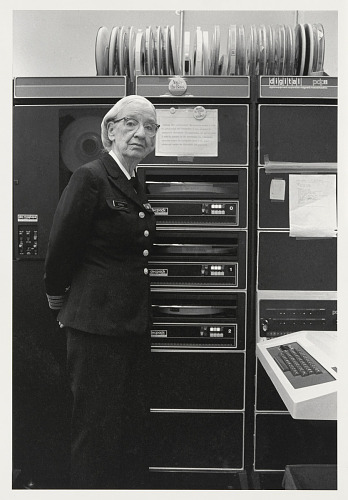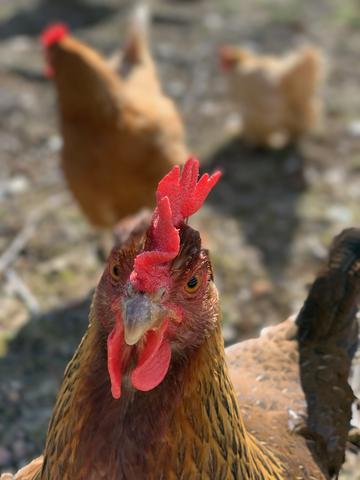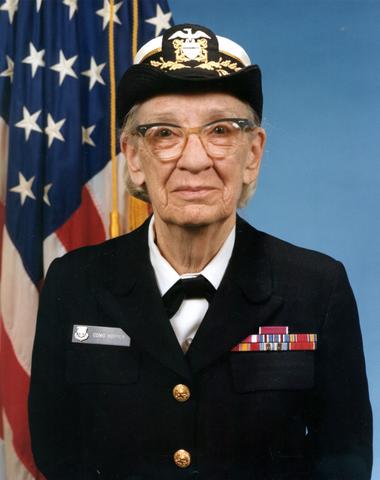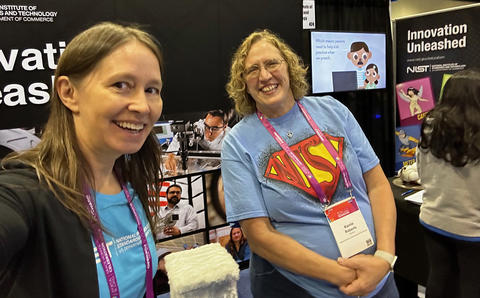Taking Measure
Just a Standard Blog
Fellowship and Fearlessness: Carrying On the Legacy of Rear Admiral Grace Hopper

As NIST technology researchers, we are inspired by Rear Admiral Grace Hopper because she broke barriers for women and was a pioneer in our field. We admire her so much that one of us (Carolyn) named a beloved family chicken after her — and Grace Hopper the chicken turned out to be the fiercest bird in the flock.
Grace Hopper’s Life and Work
Born on Dec. 9, 1906, she was a professor at Vassar College when the U.S. entered World War II. Hopper joined the Navy Reserves and used her technical skills to work on the Mark I computer; she wrote a 500-page book on the history of the computer and how to program it.
In an era when computers were used only by experts, Admiral Hopper worked on computer languages that could operate using words, not just numbers. Her work helped pave the way for computers to be used in business and, eventually, for personal use.
Admiral Hopper continued to work in industry while in the Navy. In her 60s, she returned to active duty to work on communication between computer languages. She retired as a rear admiral in the Navy at the age of 79. She died in 1992 at age 85.
Admiral Hopper was known for her no-nonsense style. She was described as “sharp-tongued” and “irreverent” by her colleagues. Many decades later, women still struggle with unfair perceptions of being “too aggressive,” but that didn’t stop Hopper. How did women like her persevere in a time when women’s struggles were basically invisible?
Grace Hopper’s Legacy — Carolyn’s Perspective
I name my family chickens after famous women in history in part to teach my children about these amazing historical figures.
Grace Hopper the chicken is definitely living up to her name. She was attacked by a fox in an incident that killed half of her flock in 2018, but Grace survived. Grace has since become the matriarch of the flock. No rooster will bother her, and she has become a first responder when trouble arises. She leads the rest of the flock out into the first snow every year. This pet bird has helped make Admiral Hopper a household name my family. It’s funny how nature works sometimes.

Hopper (the person) remains an exemplar among famously capable and determined women, and she inspires my work to this day.
As a senior computer scientist in NIST’s Engineering Laboratory, I work on federal cybersecurity operations and data management. I have had some of the same struggles that many women have had, such as being the only woman on a team of male computer scientists, having our voices minimized, being told that women don’t “do” computers, and having people assume that women are not computer scientists.
I’m sure Admiral Hopper faced these (and possibly worse) challenges, but she overcame and persevered. Looking at the women who succeeded before me has definitely given me the motivation to push through challenges and barriers. She and others like her have motivated me to want to lift up other women in computing, so they don’t have to face the same struggles.
Hopefully others will also feel energized by Admiral Hopper and other trailblazers to change the culture for women in computing. We need early-career women who are interested in computing to find their place and want to stay to encourage the next generation.
One of the ways the technology community carries on Hopper’s legacy is through a conference that brings women and nonbinary people in the industry together, known as the Grace Hopper Celebration of women in computing (GHC). The event attracts about 30,000 attendees each year. Many banks, tech companies, national labs and small businesses recruit talent there. You’ll see Apple, Tesla, Major League Baseball and JPMorgan Chase among the recruiters.
The energy at GHC would probably even impress Admiral Hopper herself. I see how first-time attendees are gobsmacked by the number of peers and the inspirational messages and talks. Some women who attend might be the only woman, or one of a few women, on their team at work. A conference like this allows women to find a community, take advantage of mentorship opportunities and make friends. At these events, I developed important relationships across NIST with colleagues I wouldn’t have met otherwise, including Kamie.
Grace Hopper’s Legacy — Kamie’s Perspective

I am thrilled to be back “home” at NIST after six years of leading the Networking and Information Technology Research and Development (NITRD) Program — the nation’s primary source of federally funded research and development in advanced IT, at the White House Office of Science and Technology Policy. At NIST, I’ve worked in a variety of technology areas, such as networking, big data and health IT. Technology evolves quickly, and my career at NIST has been varied and exciting.
I think what inspires me the most about Admiral Hopper was how much of her life she dedicated to public service. She left her career to join the military and serve the country, twice! As a 37-year NIST employee, I can relate to having a strong desire to dedicate your life to service.
The other aspects of her personality that strike me are her perseverance and her optimism. She just did what she had to do to improve technology and was so dedicated to teaching others. Computers are usable for the general public now, and that can be traced back to Hopper’s legacy and the languages she developed that used words rather than mathematical symbols.
I’m sure the revolutionary work she did, combined with being one of the few women in the field, must have been hard for her — but she never let that show. She persevered. Even with all Admiral Hopper achieved, her proudest accomplishment was all of her students.
I’ve attended the GHC many times, and I love the sense of fellowship. It’s wonderful to have 30,000-plus women in technology and engineering who are all together sharing ideas and building relationships. I come back to work so energized and inspired.
Recruiting Diverse Talent
Since we both attend this conference, we had the idea that NIST should be recruiting there, right alongside companies that are also trying to find talent. While the government certainly can’t always match the private sector in salary, NIST offers a compelling mission and many research challenges for our people — and that sense of service to the nation.

Having a booth at this conference allows candidates to really see who we are as NIST. It also demonstrates our commitment to diversifying our workforce as an organization, a high priority for us.
When women and nonbinary people walk up to our booth, we see how they feel the energy. There are also those we call “NIST fans” who just stop by the booth because they know NIST from their studies or jobs; frequently it is from our cybersecurity or artificial intelligence work.
We personally know a few women who were recruited to NIST from this conference. It’s also helped us to hire college interns, who we hope will join NIST permanently in the future.
Remembering Grace Hopper on Her Birthday
Saturday would’ve been Hopper’s 117th birthday. As Hopper was one of the most important people in the history of computer science, we will continue her legacy by encouraging a diverse talent pipeline here at NIST and in the technology industry in general.
Maybe you can remember her in some small way this week. Naming a chicken after her may sound silly, but for one of us (Carolyn), thinking about her in that peaceful part of the day helps keeps Hopper’s legacy alive for our family. Yes, I sometimes think about how far we’ve come, thanks to a chicken.
About the author
Related posts
Comments
I was at one of her presentations, and I DID receive a nine-and-one-half-inch wire. That wire traveled around a few countries until it somehow got lost. <sigh>
ADM Hopper was just terrific!
I totally enjoyed your article on ADM Hopper! What a great idea to hold a conference in her name. I am sharing it with my grandkids as I would love to see one of them select computers as a career. I retired from a state job where we conducted weights and measurements inspections. I heard NIST mentioned almost daily- it was the "Bible". Keep up the excellent work!
I love that Grace Hopper the chicken is a Rhode Island Red!
Thanks for bringing Grace to us. The article was inspiring.







Her nickname was "Grandma COBOL". ADM Hopper would give away a nine and one-half inch wire to impress on people how long it takes light to travel in a nano second. I remember one of her talks on leadership where she stressed the importance of "loyalty up and loyalty down". She was no snowflake.